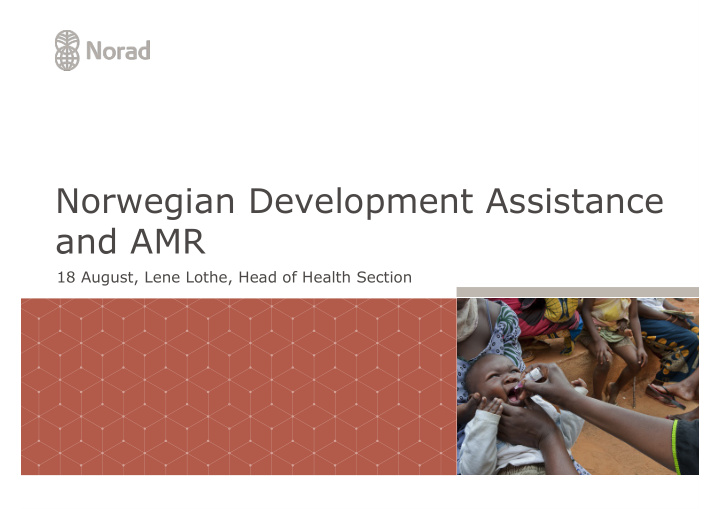



Norwegian Development Assistance and AMR 18 August, Lene Lothe, Head of Health Section
1. How is Norway involved - National strategy 2015-2020 developed (4 ministries) - Development of Global Goals and Commitments § Sustainable Development Goals § WHO: Global Action Plan on AMR, «One Health» approach § High Level Meeting, UN General Assembly 2016 - Investments (Research and ODA) 2
2. How does Norway contribute? Increase Increase access appropriate Prevent the need to diagnostics to access and for antimicrbials identify needs for adherence to antimicrobials antimicrobials 3
Global Health Investments Relevant to AMR Partner Gavi (i.e pneumocccal vaccine) UNITAID (HIV, TB, malaria treatments, diagnostics) The Global Fund to Fight AIDS, Tuberculosis and Malaria UN Commission on Lifesaving Medicines (increase access to essential medicines) Global Health Security Agenda (GHSA) through The Norwegian Institute of Public Health GLOBVAC , Research Council of Norway (NRC) NORHED , Antimicrobial stewardship and conservancy in Africa Total In addi'on (non ODA): NRC Joint Programming Ini'a've 4
Prevent the Role of vaccination in reducing AMR need for antibiotics 5
ORS and Zink instead of antibiotics Prevent the need for for Diarrhea antibiotics Norad funded program in Nigeria: - Program data suggests that antibiotic usage for diarrhoea dropped from 20% at baseline to 9% at endline in the three states. 6
Increase access to Access to appropriate treatment diagnostics to identify and diagnostics treatment needs 7
Increase Reducing the cost of diagnostics: access to diagnostics to GeneXpert identify needs for antimicrobials • 40% price reduction on diagnostic cartridges (from USD 17 to USD 10). Agreement between UNITAID, USA, Gates Foundation and manufacturer of Xpert, Cepheid. • Increase in orders in low income eligible countries (3 million orders), which helped increase case detection of MDR-TB. 8
Increase Attention to adherence in HIV, TB appropriate and malaria programs access and adherence to antimicrobials • At least 10% of newly diagnosed HIV cases are resistant to at least one ARV • 500,000 people develop MDR-TB annually • Increased resistance to antimalarials Increased use and challenges related to adherence are contributing factors to development of resistance • Reasons for poor adherence: poor access to services, financial burden, knowledge, attitudes and beliefs about treatment, side effects • Other megatrends like migration (abrupt treatment and spread of strains) as well as climatechange and urbanization may also impact AMR • Patient centered and community based approaches are explored to improve adherence 9
The UN Commission on Lifesaving Increase appropriate medicines access and adherence to antimicrobials More people die from the lack of access or delayed access to antibiotics than from resistant bacteria. UN Commission on Life Saving Commodities recommended four antibiotics: - Three injectable antibiotics for treatment of neonatal sepsis and - Amoxicillin Disbursable Tablets for treatment of childhood pneumonia. Results 2013-2015: – More countries include the preferred antibiotics on national medicines lists – Countries now experience less stock-outs of the preferred antibiotics at national level and at facility level – Greatest improvements in gentamicin (injectable) Key learnings: • Training of CCM workers to ensure appropriate use in context of AMR. Need for surveillance systems and build capacity to respond • Promotion and substitution of ceftriaxone may create an inappropriate level of demand and also eclipsing demand for other products—both contributing to the problem of AMR. Issues need stronger monitoring 10
Increase Accelerated local quality appropriate manufacturing in East Africa access and adherence to antimicrobials Ensuring quality, reducing cost and increase price competitiveness – Securing buyers – Negotiating price reductions in active pharmaceutical ingredients Key learnings: - Price influences prescription behavior, purchase and use. Risks related to AMR has been brought up as part of program assessment and program follow up. - Initiative should be accompanied with initiatives to ensure appropriate use of antibiotics 11
Concluding messages • Norad is mainly supporting the AMR agenda indirectly. But, increased focus on the risk of AMR last years. Norad has recently started to address the issue more directly in follow up of grants /technical capacity (across sectors) • As we combat the inappropriate use of antibiotics, it is equally important that we promote measures to ensure access to appropriate antibiotic treatment for those who need it. • AMR is an extremely challenging problem with potential huge impact on the ability to acheive and sustain many development goals. • Require global and multisectorial solutions and agreements – Drug regulation, quality assurance and wise pricing – Innovative research and development schemes – Individual behaviour change (disencourage excess use and promote adherence) – Health system strengthening (including quality provider/prescription behaviour, surveilance/labs etc) • The Norhed supported AMR stewardship program is a highly welcome project supporting highly needed capacity buliding and system strengthening 12
Recommend
More recommend